Pros
Cons
Introduction
Front
{{section_header}}{{section.name}}{{/section_header}}
The front of the Vizio E320VP is a flat, black plastic bezel with what appears to be a graphite-colored speaker enclosure.

Back
{{section_header}}{{section.name}}{{/section_header}}
On the back of the super-light E320VP you'll find the somewhat limited selection of ports that this set has to offer. On the right side are the manual control buttons.

Sides
{{section_header}}{{section.name}}{{/section_header}}

Stand/Mount
{{section_header}}{{section.name}}{{/section_header}}
The stand of the E320VP is a fairly basic-looking glossy black plastic piece that does not swivel. This isn't really a huge issue due to the very light weight of the TV, but we still prefer stands that allow easy access to the back of the set where the ports are.

Controls
{{section_header}}{{section.name}}{{/section_header}}
The manual controls are located on the back of the TV set, which not only is bizarre, but it seems like the only place they could have been put that would be worse would be underneath the stand. We realize that the very thin casing of the TV makes side-oriented controls impossible, but the technology exists for TVs with touch sensitive areas of the casing on the front.

Remote Control
{{section_header}}{{section.name}}{{/section_header}}
The remote of the E320VP is identical in every way to that of the Vizio E321VL, and consequently, nets the same exact score. The remote itself is angular and slightly awkward to hold and operate as the buttons are small and spread out. Operation of the TV would be more of a chore if there were more advanced options, but fortunately for the E320VP's remote, there aren't many.

In the Box
{{section_header}}{{section.name}}{{/section_header}}
The Vizio E320VP comes packaged with a stand, power cable, user manual, quick setup guide and a remote (batteries included).

Black Level
{{section_header}}{{section.name}}{{/section_header}}
The Vizio E320VP has an absolutely abysmal black level of 0.45 cd/m2. We typically don't expect entry-level LCD screens to produce the deepest blacks on the market, but this performance is just plain bad. For reference, a decent score would fall somewhere around 0.10 cd/m2, with anything falling above 0.20 cd/m2 appearing brighter than it should be. The Vizio E320VP's deepest black level is over twice as bright as that threshold. More on how we test black level.
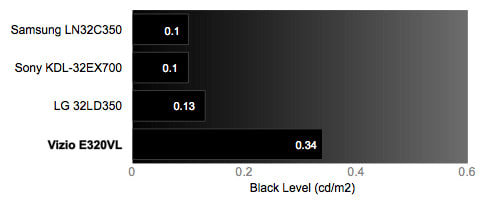
Peak Brightness
{{section_header}}{{section.name}}{{/section_header}}
Producing a bright screen is something that the E320VP doesn't struggle with, giving us a reading of 308.05 cd/m2, which is more than bright enough to provide a decent viewing experience in a well-lit room. Really, any brightness above 200 cd/m2 is adequate for this type of viewing environment, so the E320VP does fairly well in this regard. More on how we test peak brightness.
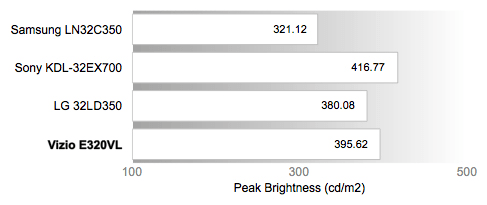
Contrast
{{section_header}}{{section.name}}{{/section_header}}
Due in part to its poor black level, the Vizio E320VP has a very poor contrast ratio of 684:1, as you can see by the provided chart. LCD screens sometimes struggle with this, especially when they fail to produce a decently low black level. Still, the E320VP struggles greatly in this area, and you may notice your picture performance suffer for it. More on how we test contrast.

Tunnel Contrast
{{section_header}}{{section.name}}{{/section_header}}
Like many other LCD screens, the E320VP had no trouble at all maintaining consistent black levels regardless of how much or how little area of the screen was occupied by black area. More on how we test tunnel contrast.
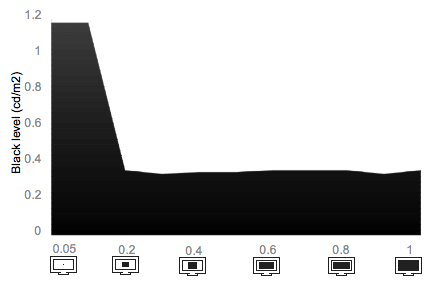
White Falloff
{{section_header}}{{section.name}}{{/section_header}}
Similarly, The E320VP had no issues in maintaining a consistent white level, regardless of how much area it occupies on the screen. We find that LCD screens typically excel in this area, and the Vizio didn't break this trend. More on how we test white falloff.
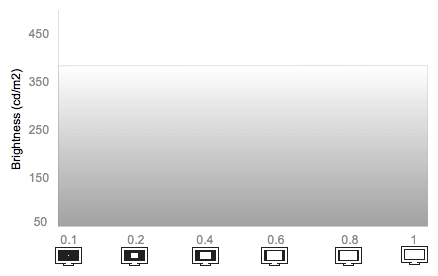
Uniformity
Greyscale Gamma
{{section_header}}{{section.name}}{{/section_header}}
When we test greyscale gamma, we look at two aspects of our charts before scoring a TV's performance: the smoothness and slope of the line. The smoothness of the line tells us whether or not there were certain values of signal intensity that the TV simply couldn't produce, or if they were produced incorrectly. Ideally, the slope of the line should lie somewhere between 2.1 and 2.2, but depending on a TV's performance, this may vary. If it does, that means it doesn't quite produce the ideal values along the greyscale, which can result in lost detail, especially in shadows.
The E320VP didn't do too badly here: as you can see below, the line was very smooth with only a slight imperfection near the darkest end of the greyscale. The slope of the line below sits at 2.59, while not ideal, isn't terrible either. In all fairness to the E320VP, you are not likely to notice much detail loss in shadows due to the greyscale gamma performance. More on how we test greyscale gamma.
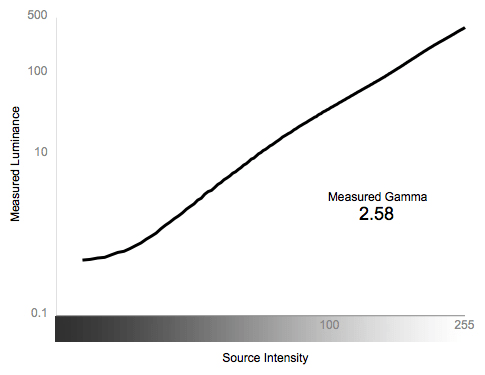
Color Temperature
{{section_header}}{{section.name}}{{/section_header}}
The E320VP didn't fare too well in our color temperature error testing, showing a notable cooling in color temperature along most of the range of signal intensity. More on how we test color temperature.

RGB Curves
{{section_header}}{{section.name}}{{/section_header}}
Here we ran into an odd result, as the RGB curves appear to peak early. Usually this is indicative of a calibration error, but then we noticed that the lines don't actually peak, but in fact they just change their slope drastically towards the brightest end of the spectrum. While that's good news for us in the lab, it's bad news for owners of the E320VP, as it means that they are liable to see a loss of differentiation between the brightest reds, blues, and greens. In addition, you may notice some color banding in gradients or shadows. More on how we test RGB curves.

Below are linear representations of the Vizio E320VP's individual RGB curves and that of the ideal response and the other comparison models. Be sure to take note of any color banding in the strips, as it shows you color values that the corresponding TV is incapable of displaying.
Motion Performance
{{section_header}}{{section.name}}{{/section_header}}
The E320VP fielded an average performance as far as motion is concerned. Still, what this means for users of the smaller Vizio is that they can expect to see images in motion skew a bit, as well as create a bunch of distracting artifacting and stair-stepping in moving objects. Overall, the E320VP could have done a lot worse, but don't expect the greatest handling of motion either. More on how we test motion performance.
3:2 Pulldown & 24fps
{{section_header}}{{section.name}}{{/section_header}}
The Vizio E320VP has a native 3:2 pulldown processing feature that handles film-based content fairly well, smoothing and easing motion transitions as well as can be expected, so the E320VP got decent marks here. More on how we test 3:2 pulldown and 24fps.
Resolution Scaling
{{section_header}}{{section.name}}{{/section_header}}
Given that this TV has a native resolution of 720p, it wasn't meant to handle larger resolutions. Still, we put the E320VP through its paces, and here is what we found: More on how we test resolution scaling.
480p
The E320VP struggled a bit with 480p content, losing 3% of its screen area vertically and 2% horizontally. Beyond this, the TV performed very well in every other resolution test while displaying 480p content.
1080i
While 1080i/p content is not supported natively by the E320VP, it is still possible to display these formats with the TV, just not very well. While displaying 1080i content, the Vizio didn't lose any screen area to overscan, but text was rendered near-illegible regardless of font size.
1080p
Much like the performance in 1080i, we found similar results displaying 1080p content. The E320VP simply could not produce legible text in this resolution.
Formats
{{section_header}}{{section.name}}{{/section_header}}
The Vizio E320VP has a native resolution of 720p and can support only a limited amount of standard NTSC resolutions.
Viewing Angle
{{section_header}}{{section.name}}{{/section_header}}
We've had instrument issues in testing television screens with in-plane switching before, but this one stumped us for quite a long while. The Vizio E320VP has a type of screen that uses a newer method of
, a screen technology that's widely renowned for increasing viewing angles, and is present in many small electronics like smartphones, media players etc.

While it gives wide viewing angles at extremely specific angles, for most viewers our data will be very misleading and inaccurate, as our testing methods account for only one plane of measurement (within that tiny range of ideal viewing angle). It's obvious that in the near future, we will have to revise our testing methods to account for this, but in the interim, we can knock off points for color errors within the recorded viewing angle. As it stands, our viewing angle chart itself is a little misleading, as it can't account for vertical viewing angle, which can make or break your viewing experience with a TV. With the Panasonic TC-L42E30 in particular, the vertical viewing angle was so tiny that it was almost impossible to view the entire screen even in ideal conditions without a precipitous drop in contrast.

The type of IPS screen that is used in this TV is most likely a variation or type of IPS very similar to an e-IPS screen, as it has almost all of the advantages and disadvantages of this particular type. The performance of the E320VP is consistent with what is described as traits of the e-IPS, namely the awful black and white performance, slight purple hue to blacks and reduced viewing angle on some planes (usually vertical).
For more on the differences between the types of LCD screens on the market, visit TFT Central.

Reflectance
{{section_header}}{{section.name}}{{/section_header}}
The E320VP has a very reflective screen that does a fair job of diffusing some light directly pointed at it. With an exceptionally bright source of light, there tends to be a large, diffuse glow on the screen that can drown out the image a bit.
Video Processing
{{section_header}}{{section.name}}{{/section_header}}
The Vizio E320VP has a handful of additional video processing modes, some more effective than others.
Calibration
{{section_header}}{{section.name}}{{/section_header}}
The Vizio E320VP was fairly easy to calibrate, once we learned the eccentricities of the menu system. What you need to know is that while the Backlight Control feature is enabled many features, such as backlight and contrast, are greyed out. Once you disable it, you're good to go. Below is a table with all the changes we made.

All of our calibration is done in conjunction with the DisplayMate software.
](http://www.displaymate.com/)
Video Modes
{{section_header}}{{section.name}}{{/section_header}}
The E320VP comes pre-loaded with a few video mode presets, described below:
Connectivity
{{section_header}}{{section.name}}{{/section_header}}
Overall, the E320VP has a small number of input and output ports for an entry-level LCD TV, mostly located on a sideways-facing panel on the rear of the set. On the rear-facing panel lie a single USB port and a few audio ports for those interested in using better speakers.

The sideways-facing input panel is home to the composite/component hybrid port, as well as the HDMI ports and your standard cable/ANT in port.
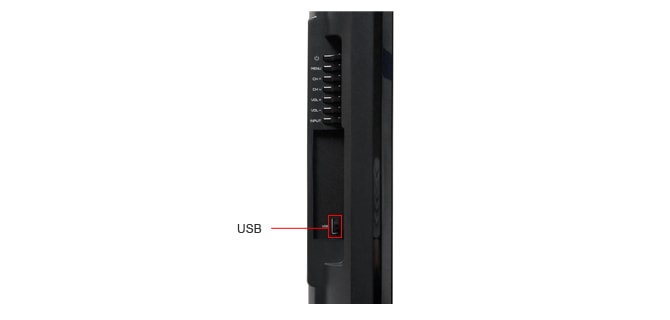
Placement
{{section_header}}{{section.name}}{{/section_header}}
The port placement is a little bizarre, but we recognize the difficulty in placing ports on a thin TV that was more or less designed around being able to mount on a wall. Still, the placement falls short of "logical," and we think Vizio could have done a better job here.
Audio Quality
{{section_header}}{{section.name}}{{/section_header}}
Even though the Vizio E320VP has two 10-watt speakers, we were surprised at how bad the sound quality was. For reference, if you played the same audio file through the speakers of the E320VP and a set of very dated PC speakers, you would probably decide to use the PC speakers when using the Vizio instead of those installed in the E320VP.
Menu Interface
{{section_header}}{{section.name}}{{/section_header}}
The menus themselves aren't too confusing or frustrating, but sometimes it can be a pain dealing with greyed-out menu options. Overall though, the basic layout is actually a plus for us, as it means we know exactly where everything is going to be without too much guesswork.

The submenus emulate the look of the parent menus, following the same format and layout, depending on what submenu it is. For reasons we can't really determine, there is an equalizer submenu that alters the audio performance of the painfully tinny speakers slightly. This probably could have been omitted.

Instruction Manual
{{section_header}}{{section.name}}{{/section_header}}
The instruction manual for the Vizio E320VP is very forgettable, with its ill-executed table of contents and awkward layout. On the whole, it contains most of the information you'd need, but it is definitely a chore to access it.

A manual for so many TV models, they have to be further categorized by type.
Internet Features
{{section_header}}{{section.name}}{{/section_header}}
The Vizio E320VP has no internet connectivity, and therefore no internet features.
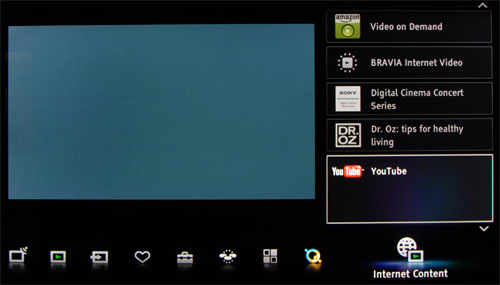
Local Media Playback
{{section_header}}{{section.name}}{{/section_header}}
The local media playback for the E320VP is limited to .jpg slideshows that are accessed through a rather frustrating autoplay format. There really isn't much you can do to control playback options.
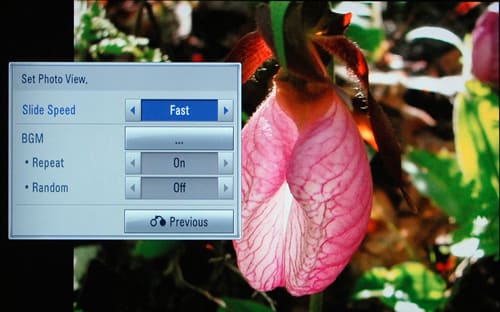
Other Media
{{section_header}}{{section.name}}{{/section_header}}
The Vizio E320VP does not support any other type of media.
Power Consumption
{{section_header}}{{section.name}}{{/section_header}}
One of the bright spots of the Vizio E320VP is the ridiculously low power consumption. The combination of the LED edge lighting and the (presumably) e-IPS display results in a TV with an estimated annual operating cost of just over $8.00USD, which is outstanding.
Even though we don't typically make a big deal about power consumption now that the cost of most LCD TVs is around $30 a year to run, we feel it necessary to point out that this TV stands out against its competition in this regard, even drawing less current than the LG 32LV2500.
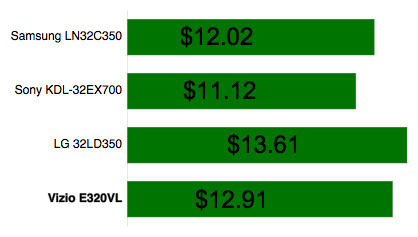
Value Comparison
{{section_header}}{{section.name}}{{/section_header}}
The Samsung LN32D450 sports a lower MSRP, and frankly, you'll get more bang for your buck with this set over the Vizio E320VP. In addition to providing a better picture quality, there are more connectivity options on the Samsung, which will be useful to those with more external media sources.
Blacks & Whites
{{section_header}}{{section.name}}{{/section_header}}
Due to the nature of the display that Vizio chose to equip the E320VP with, you'll notice a trend that its black and white performance is subpar, and that holds true in this comparison here. The Samsung LN32D450 not only has a lower black level, but also a much improved contrast ratio over the E320VP. If you watch more TV in a well-lit room, however, the Vizio might be the better pickup, as it can produce a screen brighter than 200 cd/m2, while the Samsung cannot.

Color Accuracy
{{section_header}}{{section.name}}{{/section_header}}
While neither TV did well with color accuracy, the Samsung gets the edge here by having less perceptible color temperature error than the Vizio, a slightly more accurate color gamut and more ideal RGB color curves.
Motion
{{section_header}}{{section.name}}{{/section_header}}
Both TVs net very similar scores in motion performance, so there's no major upside or downside to choosing either based on this metric.
Viewing Effects
{{section_header}}{{section.name}}{{/section_header}}
Both TVs have very different displays, as we explored earlier in the viewing effects section of the review. Still, our raw data suggests that the Vizio has a much better viewing angle than the Samsung, but it's worth noting that as these are both LCD screens, the viewing angle is never going to be as good as that of a plasma screen.
Connectivity
{{section_header}}{{section.name}}{{/section_header}}
Neither of these TVs will dazzle you with their wide array of connectivity options, but the Samsung actually has a fair number of input ports, providing you with more options than the Vizio E320VP.
Value Comparison
{{section_header}}{{section.name}}{{/section_header}}
Based on the fact that both TVs have roughly similar MSRPs, this comparison comes down strictly to performance and connectivity, which the LG provides more of. Still, be aware that the 32LV2500 has a much tinier viewing angle than the Vizio E320VP, so if you're buying a set for a wider room, you may want to stick with the Vizio.
Blacks & Whites
{{section_header}}{{section.name}}{{/section_header}}
To no surprise, the LG outperforms the Vizio E320VP in black and white performance, recording a lower black level, comparable peak brightness, and a much wider contrast ratio. If you're looking for solid performance here, the LG takes this category.

Color Accuracy
{{section_header}}{{section.name}}{{/section_header}}
Neither TV impressed in color performance, but there are some strange numbers to compare between these two sets: while the Vizio showed less total color temperature error, and a more accurate color gamut, the LG had better RGB curves. Still, the Vizio is probably the better TV by this comparison alone.
Motion
{{section_header}}{{section.name}}{{/section_header}}
Both sets were painfully average in handling motion, with the slight edge going to the LG. You really can't go wrong here.
Viewing Effects
{{section_header}}{{section.name}}{{/section_header}}
The LG doesn't have the same type of screen as the Vizio, so the issues we noted earlier to not apply to the 32LV2500. Still, it brings its own troubles to the table, having an absolutely miniscule viewing angle. Despite our troubles in measuring the Vizio's true viewing angle, we feel confident in saying it has the superior viewing angle.
Connectivity
{{section_header}}{{section.name}}{{/section_header}}
With 3 HDMI ports and double the analog options of the E320VP, the LG 32LV2500 gives you more options in terms of connectivity. Both sets lack internet capability.
Value Comparison
{{section_header}}{{section.name}}{{/section_header}}
If you don't mind shelling out the extra cash for the Sony KDL-32EX520, you will be rewarded with better picture quality, much more connectivity options and internet content, which is a very nice plus. The viewing angle isn't as good as the Vizio's, but you're getting value for the extra cost. Depending on what's important to you in a TV, each set has their ups and downs.
Blacks & Whites
{{section_header}}{{section.name}}{{/section_header}}
Like every single other comparison model, the Sony blew the Vizio away in terms of black and white performance, with a much lower black level, acceptable peak brightness and much wider contrast ratio.

Color Accuracy
{{section_header}}{{section.name}}{{/section_header}}
Unlike the other comparison model TVs for this review, the Sony is the clear winner here, as it scores as well as the Vizio or better in each metric that we score color performance by, with much less color temperature error, better RGB curves and a relatively similar color gamut performance.
Motion
{{section_header}}{{section.name}}{{/section_header}}
The Vizio didn't impress in terms of motion performance, but the Sony is just bad. Don't expect high performance out of either of these TVs, though.
Viewing Effects
{{section_header}}{{section.name}}{{/section_header}}
The Sony has a different type of LCD screen than the Vizio, so none of the issues we noted earlier apply to it. That being said, the Sony KDL-32EX520's viewing angle is roughly half that of the Vizio's.
Connectivity
{{section_header}}{{section.name}}{{/section_header}}
The Sony KDL-32EX520 offers much, much more in terms of connectivity than the Vizio E320VP. It sports double the HDMI ports of the Vizio, more analog audio out options as well as internet connectivity, which the Vizio lacks. If this is something important to you, stick with the Sony.
Conclusion
For what it is, the Vizio E320VP ($549 MSRP) isn't a bad entry-level LCD for its size. It certainly leaves a lot to be desired, but let's be honest: if you're buying a 32-inch screen, you're probably not buying a centerpiece for a high-performance home entertainment system.
Still, it's worth noting that the E320VP's screen, while extremely energy efficient, has absolutely horrible picture performance. It's a tradeoff to be sure, but this TV isn't going to impress anyone in terms of raw performance. This may or may not be due to the cheaper type of IPS screen used by Vizio in this TV, but if this is true, why bump up the MSRP on a TV with poor performance? We'll let you decide if the pros are worth the cons. In the end, it's what you want to use a TV for that dictates what set you end up with.
Model Series Comparison
{{section_header}}{{section.name}}{{/section_header}}
The Vizio Exx0VP series consists of two seperate televisions, the 720p E320VP and the 1080p E370VP. Both offer similar features and performance, as well as connectivity options.
Photo Gallery
{{photo_gallery "Front Tour Image", "Back Tour Image", "Sides Tour Image", "Stand Photo", "Controls Photo", "Remote Control Photo", "Connectivity Tour Image 1", "Connectivity Tour Image 2", "Connectivity Extra Photo", "Menu Main Photo", "Menu 2 Photo", "Internet Features 1 Photo", "Internet Features 2 Photo", "Internet Features 3 Photo", "Local Media Playback 1 Photo", "Local Media Playback 2 Photo"}}
Ratings & Specs
{{manufacturer_specs_table}}
Meet the tester
A seasoned writer and professional photographer, Chris reviews cameras, headphones, smartphones, laptops, and lenses. Educated in Political Science and Linguistics, Chris can often be found building a robot army, snowboarding, or getting ink.
Checking our work.
Our team is here to help you buy the best stuff and love what you own. Our writers, editors, and experts obsess over the products we cover to make sure you're confident and satisfied. Have a different opinion about something we recommend? Email us and we'll compare notes.
Shoot us an email